Little Deuce Cup, You Don't Know What I Got
Tracking the Origins and Present Status of Queens' Own Mint Julep—the Honey Deuce of the U.S. Open.
The two most famous sports-related cocktails in the world are the Mint Julep, for which thousands of mint plants are sacrificed every Kentucky Derby, and the Pimm’s Cup, drunk by the tankful at Wimbledon each year. But lately the U.S. Open’s official drink, the Honey Deuce, has been making a strong case for placing third.
It is far younger than those two drinks, having been introduced only 17 years ago by Open sponsor Grey Goose vodka. Yet, an impressive 405,000 Honey Deuces, at $22 a pop (which includes the collectable cup—more on that later), were sold and drunk during the 2022 Open.
To walk through the rarified shopping mall that constitutes the Open’s grounds is to know you are only a guest in Honey Deuce Land. The drink rules the landscape. It is easily spotted by its light pink hue and distinctive melon-ball garnish. You’ll see it in every hand and atop every table. It rests on ledges in front of people’s seats as they watch the game, as well as under their chairs.
By the end of Saturday’s women’s final, all the concession stands selling Honey Deuces had run out of the commemorative cups. A man at the largest of the Grey Goose vodka stands told me they had done $70,000 in business as he handed me my final Honey Deuce of the day, demoted to a plain plastic cup. That’s roughly 3,200 drinks. A smaller stand run by only two women, just a cart really, told me they had sold 600 that day.
There are two things that set the Honey Deuce apart from the Mint Julep and Pimm’s Cup. One, it was created specifically for the sporting event where it is primarily enjoyed. The Mint Julep had existed for nearly two centuries before the Kentucky Derby claimed the drink as its own in the 1930s. And the Pimm’s Cup was a popular British quaff long before it began lubricating the crowds at Wimbledon.
And Two, we know who invented the Honey Deuce. That person is Nick Mautone, a career hospitality professional and one of the key early figures in New York’s cocktail renaissance. Mautone advanced the craft cocktail cause when he was in charge of the beverage programs at Hudson Grill and Gramercy Tavern in the 1990s, working with chefs Waldy Malouf and Tom Colicchio, respectively. He may have been the first person in New York to insist on housemade cocktail cherries and onions for his Manhattans and Gibsons. In 2004, he published Raising the Bar, one of the first cocktail manuals of the modern era.
Mautone was working as a Grey Goose brand ambassador in 2005, the year the vodka brand become a sponsor of the U.S. Open. The Open’s previous official cocktail has done lackluster business, only 10,000 serves over two weeks. Mautone was charged with creating a better performer.
As Mautone tells the story, he was on his way to his home on Long Island when he stopped at a farm stand and picked up some Honeydew melons, blackberries and fresh rosemary. While putting together his own version of the traditional Italian appetizer of melon and prosciutto in his kitchen, he noticed the Honeydew melon balls he was making looked like tiny tennis balls. That became “the non-negotiable garnish” of the yet-to-be-created new cocktail. Given Mautone’s serious garnish credentials, that he would dream up a fresh-melon-ball garnish makes perfect sense.
The drink he tested out in front of the U.S. Open’s catering team was a bit too complex, using a rosemary-citrus syrup along with the melon balls and requisite Grey Goose vodka base. Mautone wanted a long drink that was cool and refreshing, because days at the Open can be brutally hot. Eventually a compromise was reached, and the syrup was replaced by lemonade and a splash of the French raspberry-blackberry liqueur Chambord. This made the cocktail an easier serve, an important issue in a high-volume setting like Arthur Ashe Stadium.
The melon balls remained non-negotiable. This is rather remarkable when you think about it, as three melon balls on a pick makes for a rather unwieldy garnish. Mautone found a co-packer in New Jersey that delivered the balls daily to the stadium, pre-cut and frozen. Today, according to Grey Goose, the melon balls arrive fresh. There is little chance of them going bad, since Honey Deuces fly out at lightening speed at the Open. There is more chance, actually, of bars running out of the melon balls. But, according to several people I asked, this has never happened. One server sold me the melon-ball people are on “24/7” call and boxes of the fruit arrive regularly at the stadium.
Mautone’s creation did the trick. In its first year, 30-40,000 Honey Deuces were were sold. The numbers have increased every year since.
Writer and regular U.S. Open attendee Andrew Friedman recalled his first encounter with the Honey Deuce. Friedman is uniquely qualified to have an opinion on the drink and its rise. He was for many years an editor-at-large at Tennis magazine. As an accredited tennis journalist, he attended the Open daily for a decade. He is also the author of several cookbooks, many of them written in collaboration with famous chefs. Because of Friedman’s dual writing focus, his editor assigned him to taste through the Open’s food offerings in 2007. This was shortly after the Honey Deuce was introduced.
“Then it was kind of a newish thing,” said Friedman. “The person who guided my tasting said, ‘We want this to be to the U.S. Open what the Mint Julep is to the Kentucky Derby.’ Which surprised me, because generally I think things like that happen organically.”
Friedman had to admit, however, that Team Honey Deuce had largely succeeded in their stated mission.
“I think it is a triumph of the will of Grey Goose and whoever has the contract for the overall food service,” he said. “That is the drink. It’s kind of being pushed on you the whole time you’re there.”
The Honey Deuce has also spun off the concomitant cottage industry in commemorative cup collections—a phenomenon recently reported on by the New York Times.
The Honey Deuce plastic cup lists all the past winners of the U.S. Open. This means that each year’s cup is different from the previous one. Some people, I am told, buy tickets to the Open just to buy the drink and collect the cup, and leave the stadium without watching a single match. There is also a healthy market for Honey Deuce cups on eBay. The 2023 cups are already for sale on the site. Sample price: 6 cups for $39.99.
Friedman told me that, at the close of a recent day of play, he saw two men going through the stands collecting all the abandoned Honey Deuce cups they could carry.
Mautone, who ceased being a Grey Goose ambassador in 2015, says the Honey Deuce is his best known cocktail creation by far. “I did not expect it to hit this volume,” he said. Mautone hastens to point out that the Honey Deuce took off with the public before social media was around to track food and drink trends. This, he contends, makes the drink’s success all the more remarkable.
That said, social media has been very good to the Honey Deuce. Particularly this year. The Honey Deuce was inescapable on Instagram.
“The melon ball garnish and collector's cup are really what sell it, and are what make the drink so identifiable and Instagrammable,” said journalist Tammie Teclemariam, who attended the Open this year. “I think this year might have hit peak sales just because the event became really popular this year, and so it was more of a status symbol. Though I'm pretty sure that event could sell lots of $22 drinks no matter what.”
All told, 2.25 million Honey Deuces have been sold at the Open since the drink was introduced in 2006. And, in recent years, the drink has begun to be seen at certain New York bars during the two weeks of U.S. Open, including the vaunted cocktail den Dante.
Linden Pride, an owner of Dante, said he started serving a version of the Honey Deuce in 2020.
“That year the U.S. Open was players and players staff only, with no spectators due to the pandemic,” he said. “We were invited to do a run a Dante pop-up in the players camp for the duration of the tournament. It was an amazing two weeks where we really got to know a lot of the players, who would celebrate and commiserate with us.”
Dante developed its own take on the drink that year. It is more influenced by a Japanese Slipper cocktail than the original Honey Deuce, incorporating Midori, and fluffy Honeydew melon juice.
“It’s been so popular, folks write to us and check whether we will bring it back each year,” said Pride. “The open is such a celebration of NYC, we love to be a part of that.”
It is difficult not to be impressed with the success of the Honey Deuce when you consider the recent track record of sporting cocktails, a history that is littered with drinks that have failed to launch. The Saratoga Sunrise, a lazy vodka riff on the Tequila Sunrise meant to honor the racing season at Saratoga Springs, New York, never became the big thing is was supposed to be, despite having its own souvenir cup.
The official drink of the Belmont Stakes is something called the Belmont Jewel. It is made with Bourbon, lemonade, pomegranate juice and a lemon twist. But the Jewel has enjoyed that status only since 2012. Before that, the official drink was the Belmont Breeze, introduced in 1998, and made of Bourbon, sherry, orange juice, cranberry juice and mint. And before that, it was the White Carnation, which was composed of a splash of cream mixed with vodka, peach schnapps and orange juice—truly a drink of its era. Belmont, it seems, just can’t make up its mind.
The Preakness Stakes has enjoyed more success. Their official drink, the Black-eyed Susan, was created in 1973 and is still on the menu at Pimlico. It was invented by a man named Harry Stevens, one of Pimlico’s longtime caterers. His intent was to create a cocktail that imitated the coloring of the Maryland state flower, the Black-Eyed Susan. A curious impetus, but inspiration springs from all corners. The result is a bourbon sour made with peach schnapps, vodka, orange juice, sour mix and and orange and cherry garnish. (There really is far too much orange juice being drunk in sporting circles.)
Fifty years is a pretty good run. However, I have never met anyone who urgently needed to lay their hands on a Black-eyed Susan the day of the Preakness Stakes the way people crave a Mint Julep on Derby Day.
Such cocktails seem to only adorn the more high-toned sports, such as tennis and horse racing. People drink beer at baseball, basketball, football and hockey games and I haven’t yet heard of anybody trying to change that status quo. As to why that is, Mautone has a theory.
“I think it’s because it is a tightly knit event,” he said. “They are short term. The U.S. Open is two weeks. Same thing with Wimbledon and so on. There is a beginning and end to the event and that lends itself to a signature drink.”
It took me until this year to try my first Honey Deuce. I had seen the drink pop up here and there at bars during the two-week span of the U.S. Open. But I never seriously considered ordering one. As a booze journalist, I have a natural suspicion of brand-born cocktails. That kept me rooted in the skeptic’s camp. However, when confronted with the enormous success of the drink, at least in terms of numbers, it seemed foolish and even irresponsible to continue to ignore the cocktail.
Still, I didn't want my first Honey Deuce to be at some random Manhattan bar or at home. It seemed only right to experience the drink on its home turf. So I hopped on the G train, transferred to the 7, and went to Arthur Ashe Stadium—for the first time, as it happened. Some New York landmarks escape you no matter how long you live here.
The lines to buy Honey Deuces were at least a half-hour long. The line at the so-called “Honey Deuce Express” stand—the Open’s version of the express checkout, where you could only order that cocktail—weren’t any shorter. But people seemed willing to wait.
The big surprise for me was how likable the drink was. I’m not a vodka drinker. And I can’t remember the last time I bought or drank Chambord. But as a summer cooler, the Honey Deuce works. Friends had told me it was a sugar bomb, but I didn't find it overly sweet. As to the melon balls, Honeydew, with its delicate flavor, has always been my favorite melon. My mother grew them in her garden every summer.
And I had to admit that drinking one while watching the play on the court lent a certain sense of occasion to the proceedings.
A new addition in the last few years is the frozen Honey Deuce, which, for my money, is the best version of the cocktail. As with many frozen versions of popular cocktails, the slushy version intensifies the drink’s natural flavors. The only problem in the drink freezes the melon balls solid.
At press time, a spokesperson for Grey Goose vodka told me Honey Deuce sales for 2023 had surpassed the previous year by at least 45,000. That 450,000 drinks.
Or 1.35 million melon balls.
The Kentucky Derby people report that 120,000 Mint Juleps are sold over the two-day event. That’s 60,000 Juleps a day, compared to roughly 32,150 a day during the 14-day U.S. Open.
So the Honey Deuce still has some work to do. But it’s getting there.
Honey Deuce
Nick Mautone, New York City, 2016
As with all globular garnishes, there should be three melon balls. Two is bad luck and one is stingy. Feel free to up the vodka amount. I can’t guarantee it, but I’m pretty sure the Honey Deuces I had at the open were stronger than anything 1 1/4 ounces of vodka could deliver.
1 ¼ ounce Grey Goose vodka
3 ounces fresh lemonade
1/2 ounce Chambord
3 Honeydew melon balls for garnish.
Fill a chilled highball glass with cubed ice and add vodka. Top with fresh lemonade and, lastly, the Chambord, applied so the liqueur trickled slowly into the drink. Garnish with a skewer of three fresh honeydew melon balls.

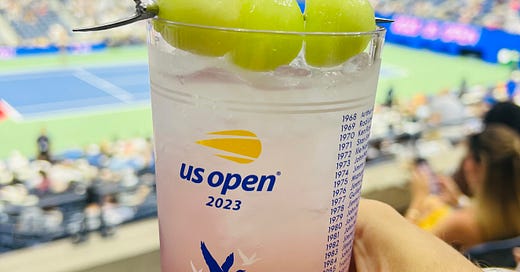




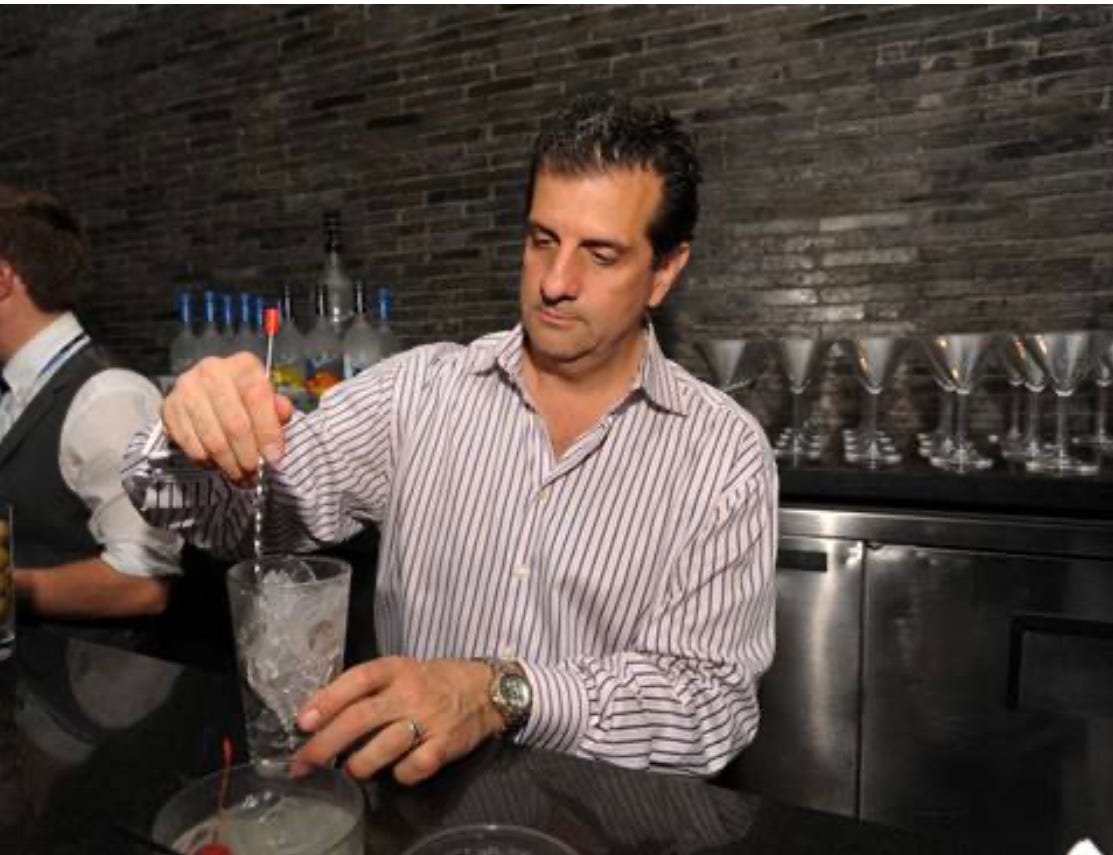

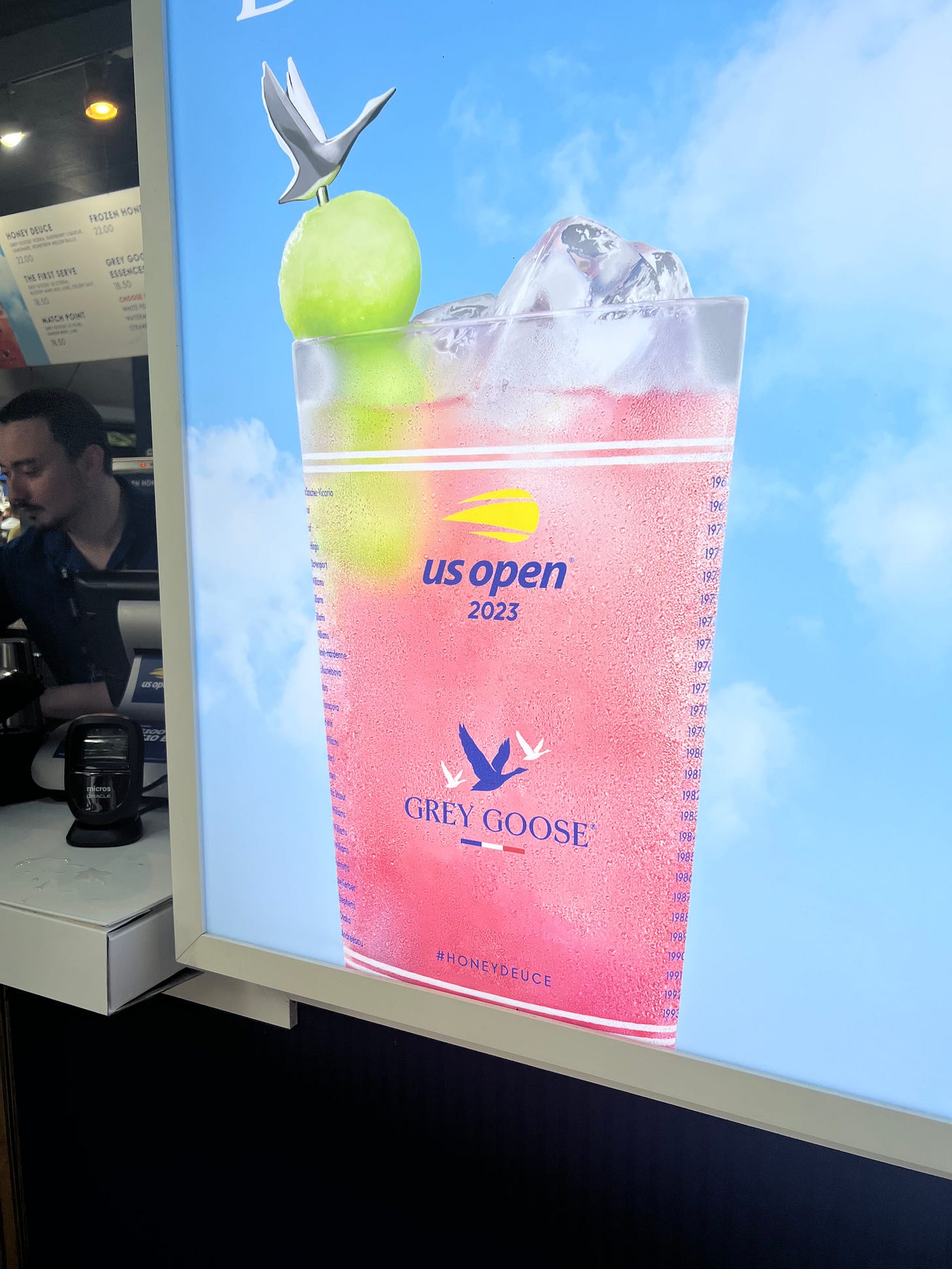
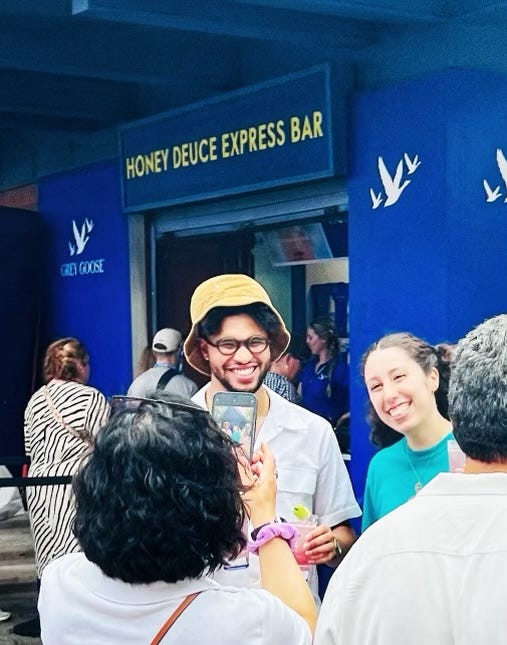
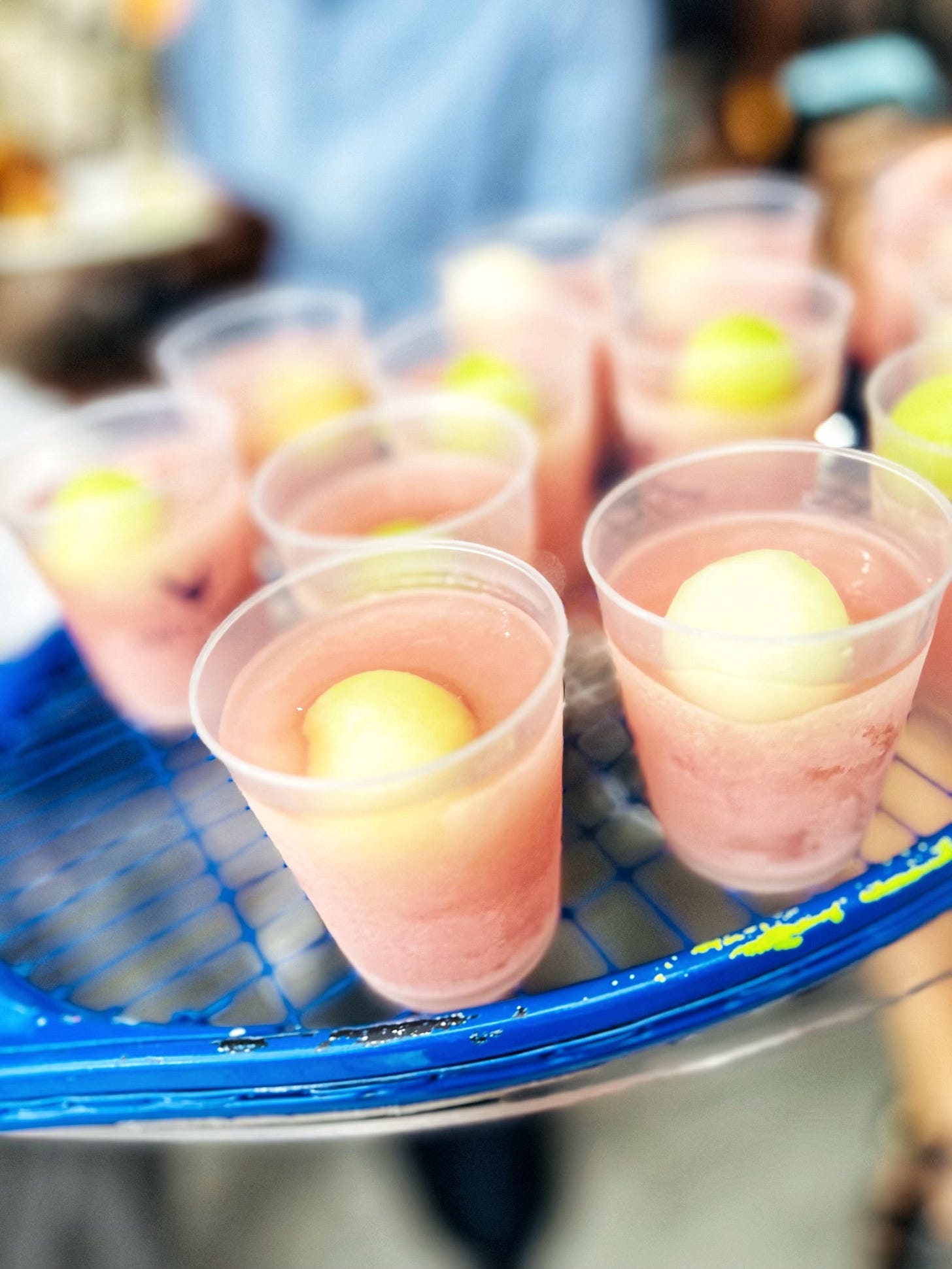
I love this story! What the deuce!!
Going to make one tonight. Damn it sounds good! Love the story.